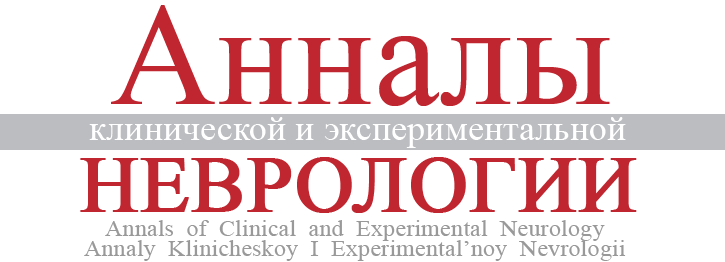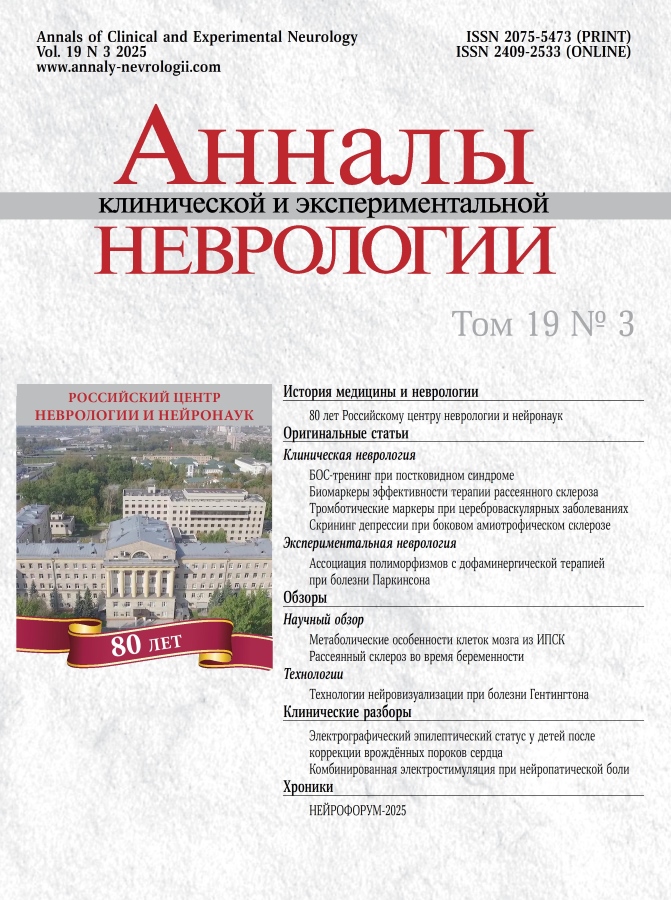Combined spinal cord and peripheral nerve stimulation in severe neuropathic pain syndrome
- Authors: Kondratyev V.P.1, Isagulyan E.D.1, Tomskiy A.A.1
-
Affiliations:
- N.N. Burdenko National Scientific and Practical Center for Neurosurgery
- Issue: Vol 19, No 3 (2025)
- Pages: 100-104
- Section: Clinical analysis
- Submitted: 05.05.2025
- Accepted: 16.06.2025
- Published: 10.10.2025
- URL: https://annaly-nevrologii.com/pathID/article/view/1355
- DOI: https://doi.org/10.17816/ACEN.1355
- EDN: https://elibrary.ru/CEGAFE
- ID: 1355
Cite item
Abstract
Introduction. Chronic severe neuropathic pain syndrome (NPS) refractory to conservative and surgical treatments remains a significant clinical challenge. Chronic electrical stimulation of a single neural structure often proves insufficiently effective, highlighting the need for innovative approaches such as combined neuromodulation. This article aims to present a clinical case of combined spinal cord and peripheral nerve stimulation. A case report. A 32-year-old female with iatrogenic injury to the sural nerve following surgical intervention presented with refractory NPS (8 points on VAS). Failed conservative therapy (gabapentin, duloxetine) and surgical management (neuroma excision) led to chronic spinal cord stimulation, achieving 30% pain reduction. Subsequent ultrasound-guided peripheral nerve electrode implantation combined with chronic electrical stimulation resulted in complete pain area coverage and pain intensity reduction to 1–2 points on VAS.
Conclusion. Technical challenges associated with combined neuromodulation should not preclude its clinical application. Electrode proximity does not significantly affect system performance. Combined neuromodulation demonstrated synergistic effects in pain management by enhancing analgesia through simultaneous modulation of central and peripheral pain mechanisms. Large-scale studies evaluating the safety and efficacy of this combined approach are required for routine clinical implementation.
Full Text
Introduction
The prevalence of post-traumatic neuropathy developing as a result of surgical interventions ranges from 3% to 15% [1]. Studies indicate that 6–30% of patients with this condition have chronic neuropathic pain syndrome (NPS) [2]. Several studies evaluating the efficacy of conservative therapy demonstrate that achieving ≥ 50% pain reduction with monotherapy is possible in only 20–30% of patients, while combined pharmacological approaches show better analgesic effects but are not universally effective [3]. Surgical methods, including neurolysis and neurectomy, demonstrate effectiveness in only 50–70% of cases [4, 5], highlighting the need for innovative treatment approaches. In this context, neuromodulation techniques such as chronic spinal cord stimulation (SCS) and peripheral nerve stimulation (PNS) are gaining relevance. This article presents a clinical case of combined SCS and PNS in a patient with chronic pharmacoresistant NPS due to sural nerve neuropathy, along with an analysis of current evidence on their efficacy.
Clinical case report
Patient S., a 32-year-old female, underwent surgical removal of a subcutaneous lipoma located on the dorsolateral surface of the left foot posterior to the lateral malleolus. In the early postoperative period, she developed a severe burning pain syndrome radiating along the lateral foot surface, accompanied by paresthesias and hypesthesia of the toes. Pain intensity reached 8 points on the visual analog scale (VAS). Neurological examination and instrumental diagnostics confirmed iatrogenic injury to the sural nerve (n. suralis) in the surgical access area. Sequential attempts at surgical management (marginal neurectomy) and conservative therapy (gabapentin 900 mg/day, duloxetine 60 mg/day, venlafaxine 150 mg/day) proved ineffective, showing only short-term analgesic effects with pain recurrence before subsequent dosing. In 2022, the patient underwent implantation of a chronic spinal cord stimulation (SCS) system at Th10-Th12 levels (Fig. 1). Stimulation-induced paresthesias covered 80% of the pain area and reduced pain intensity by 30%.
Fig. 1. Radiographic image of the implanted electrode in the posterior epidural space at the T10–T12 vertebral levels.
In 2023, the patient presented to the N.N. Burdenko National Medical Research Center of Neurosurgery, where she underwent a sural nerve block. Complete regression of the pain syndrome was observed during the local anesthetic effect, with complete recurrence of pain occurring on days 2–3 post-block. Consequently, a decision was made to implant an electrode for chronic electrical stimulation of the n. suralis under ultrasound guidance. A 3 cm linear incision was made on the posterolateral surface of the calf, through which the n. suralis trunk was identified under ultrasound guidance. Using a Tuohy epidural needle (provided with the electrode kit), the electrode was implanted parallel to the n. suralis course and secured at the incision site with a thick non-absorbable silk suture (5 metric) (Figs. 2, 3).
Fig. 2. Intraoperative photograph. Ultrasound-guided electrode implantation on the sural nerve (n. suralis).
Fig. 3. Ultrasound image of the implanted electrode.
Left: transverse scan. The electrode runs along the trunk of the sural nerve (n. suralis) at a distance of less than 1 mm from it. Right: longitudinal scan. Aligning the electrode and n. suralis in the same plane is extremely challenging due to their spatial relationship, but the electrode shadow and epineurium of n. suralis can be visualized.
The main challenge was advancing the distal end of the electrode to the upper gluteal region, where a subcutaneous pulse generator had previously been implanted. Given the patient’s height of 170 cm, the distance from the lateral malleolus to the generator measured approximately 100 cm, necessitating a loop system to compensate for joint movements. Additional 2 cm incisions were made in the upper third of the calf and middle third of the thigh; through a subcutaneous tunnel, 55 cm and 35 cm extensions were placed, and two compensatory loops were formed (Fig. 4). This achieved a total system length of 140 cm, eliminating the risk of electrode tension during limb flexion-extension movements. Impedance testing was then performed, which remained within normal limits. The procedure concluded with layered wound closure.
Fig. 4. Photograph of postoperative wounds on day 3 after surgery.
Several hematomas were observed in the loop pocket bed, but they had no clinically significant effect and resolved spontaneously within several weeks.
On the following day, neurostimulation programming was adjusted, resulting in complete coverage of the pain area. Combined neurostimulation (SCS + PNS) reduced neuropathic back pain intensity to 1–2 points on the VAS (Fig. 5). At 24-month follow-up, depletion of the implanted pulse generator’s battery was noted, requiring its replacement. Pharmacotherapy was maintained at the previous dosage.
Fig. 5. Changes of pain intensity (VAS scores) over time depending on the treatment method.
Discussion
The presented clinical case demonstrates the potential of combined neuromodulation in managing complex pain syndromes. According to randomized controlled trials, PNS monotherapy achieves ≥ 50% pain reduction in 38% of patients with posttraumatic neuropathy [6], while a systematic review highlights variability in efficacy (38–78%) depending on injury etiology and location [7]. SCS provides analgesic effects in 50–70% of patients [6, 8]. Several clinical cases describe combined PNS and SCS use with superior analgesic outcomes compared to either modality alone [9–12].
The synergistic mechanism likely involves simultaneous modulation of both spinal and peripheral nociceptive pathways. SCS acts on the dorsal horns of the spinal cord, suppressing central sensitization, while PNS blocks peripheral hyperexcitability of damaged nerves [9]. However, the lack of randomized controlled trials on combined stimulation limits the evidence base, and the increased risk of complications (electrode migration, intraoperative structural damage, infections) necessitates careful patient selection, surgical procedures, and post-operative follow-up.
Another distinctive feature of this clinical case was the remote location of the electrode relative to the generator. When implanting electrodes on the nerves of the lower leg, the generator is typically placed in the lateral thigh area. However, in this case, a generator was already implanted, necessitating the use of multiple extension leads to bridge the distance and minimize the risk of tension on the electrode and extensions, which we successfully achieved. Notably, there was no significant increase in circuit impedance, which remained around 800 ohms, allowing the use of low stimulation amplitudes and conservation of the generator’s battery charge.
Conclusion
The management of NPS refractory to conservative treatments requires a multimodal approach integrating pharmacotherapy, interventional procedures, and neuromodulation techniques. Combined electrical stimulation (SCS + PNS) represents a promising strategy to enhance analgesic effects by targeting multiple pathophysiological components of pain syndromes. The remoteness of the intended stimulation target should not preclude the use of combined modalities. However, the implementation of this strategy in clinical practice must be accompanied by large-scale randomized controlled trials to evaluate long-term efficacy and safety, as well as the development of algorithms for personalized neuromodulation approaches.
About the authors
Viktor P. Kondratyev
N.N. Burdenko National Scientific and Practical Center for Neurosurgery
Author for correspondence.
Email: vstenv@gmail.com
ORCID iD: 0000-0003-3272-8699
SPIN-code: 9705-3018
postgraduate student, 6th Neurosurgical department (craniofacial neurosurgery) with the group “Functional neurosurgery”
Russian Federation, MoscowEmil D. Isagulyan
N.N. Burdenko National Scientific and Practical Center for Neurosurgery
Email: emisagulyan@gmail.com
Cand. Sci. (Med.), senior researcher, 6th Neurosurgical department (craniofacial neurosurgery) with the group “Functional neurosurgery”
Russian Federation, MoscowAlexey A. Tomskiy
N.N. Burdenko National Scientific and Practical Center for Neurosurgery
Email: alexey_tomskiy@mail.ru
ORCID iD: 0000-0002-2120-0146
Cand. Sci. (Med.), Assoc. Prof., Department of neurosurgery with courses in neuroscience, senior researcher, 6th Clinical department, neurosurgeon, Head, Functional neurosurgery group
Russian Federation, MoscowReferences
- Kretschmer T, Heinen CW, Antoniadis G, et al. Iatrogenic nerve injuries. Neurosurg Clin N Am. 2009;20(1):73–90. doi: 10.1016/j.nec.2008.07.025
- Яхно Н.Н., Кукушкин М.Л., Данилов А.Б. и др. Результаты Российского эпидемиологического исследования распространенности невропатической боли, ее причин и характеристик в популяции амбулаторных больных, обратившихся к врачу-неврологу. Российский журнал боли. 2008;(3):24–32.
- Yakhno NN, Kukushkin MV, Danylov AB, et al. Results of Russian epidemiological study of neuropathic pain (nep) prevalence among patients applying for neurological care (epic). Russian Journal of Pain. 2008;(3):24–32. doi: 10.1016/S1090-3801(09)60555-3
- Давыдов О.С., Яхно Н.Н., Кукушкин М.Л. и др. Невропатическая боль: клинические рекомендации по диагностике и лечению Российского общества изучения боли. Российский журнал боли. 2018;(4):5–41.
- Davydov OS, Yakhno NN, Kukushkin MV, et al. Neuropathic pain: clinical guidelines on the diagnostics and treatment from the Russian Association for the Studying of Pain. Russian Journal of Pain.2018;(4):5–41. doi: 10.25731/RASP.2018.04.025
- Blanton N, Bui P, Rizzo D. Neurologists, neuroctomy, and grafting for chronic lower extremity pain following major rearfoot reconstruction. The Foot and Ankle Online Journal. 2019;12(4):2.doi: 10.3827/faoj.2019.1204.0002
- Gosk J, Rutowski R, Rabczyński J. The lower extremity nerve injuries — own experience in surgical treatment. Folia Neuropathol. 2005;43(3):148–152.
- Deer TR, Mekhail N, Provenzano D, et al. The appropriate use of neurostimulation: avoidance and treatment of complications of neurostimulation therapies for the treatment of chronic pain. Neuromodulation Appropriateness Consensus Committee. Neuromodulation. 2014;17(6):571–598. doi: 10.1111/ner.12206
- Xu J, Sun Z, Wu J, et al. Peripheral nerve stimulation in pain management: a systematic review. Pain Physician. 2021;24(2):E131–E152.
- Kumar K, Taylor RS, Jacques L, et al. Spinal cord stimulation versus conventional medical management for neuropathic pain: a multicentre randomised controlled trial in patients with failed back surgery syndrome. Pain. 2007;132(1–2):179–188. doi: 10.1016/j.pain.2007.07.028
- Baxter AL, Thrasher A, Etnoyer-Slaski JL, et al. Multimodal mechanical stimulation reduces acute and chronic low back pain: pilot data from a HEAL phase 1 study. Front Pain Res (Lausanne). 2023;4:1114633. doi: 10.3389/fpain.2023.1114633
- Lipov E.G. Hybrid neurostimulator: simultaneous use of spinal cord and peripheral nerve field stimulation to treat low back and leg pain. Prog Neurol Surg. 2011;24:147–155. doi: 10.1159/000323047
- Bernstein CA, Paicius RM, Barkow SH, et al. Spinal cord stimulation in conjunction with peripheral nerve field stimulation for the treatment of low back and leg pain: a case series. Neuromodulation. 2008;11(2):116–123. doi: 10.1111/j.1525-1403.2008.00152.x
- Choi JH, Choi SC, Kim DK, et al. Combined spinal cord stimulation and peripheral nerve stimulation for brachial plexopathy: a case report. Pain Physician. 2016;19(3):E459–E463.













